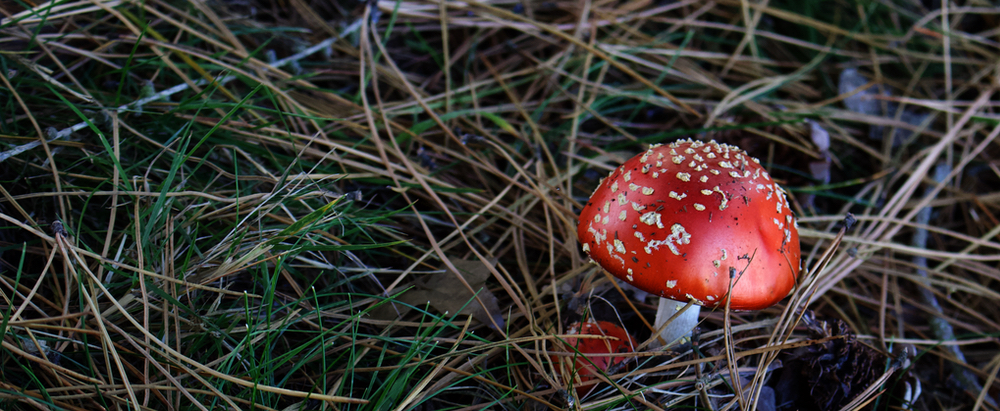
This Year's Pumpkin Harvest
Hello friends,
Every year I make an effort to grow as many pumpkins as I can—not only for ourselves, but also for family and friends too. We're typically not big pumpkin eaters, well except for pumpkin soup. We make it up in bulk when all the ingredients for the recipe have been harvested, and include our own homegrown potatoes, onions, and garlic. Once made, we freeze our pumpkin soup away in meal-sized portions, and eat it all through autumn and winter for lunches since hubby and I both work from home.
Back in September 2022, I decided to sow baby bear and also grey crown varieties of pumpkin seeds for the upcoming growing season. The first sowing didn't germinate thanks to some dodgy seed raising mix, so I had to resow the pumpkin seeds in early October. This time all the seedlings germinated and grew up into healthy plants. In Labour weekend in October they were planted into one of our large garden beds along with corn and wheat.
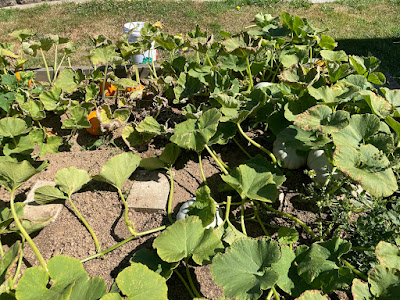
This past growing season had the hottest and driest weather for us in Dunedin in many years. The pumpkin plants grew very quickly, and before Christmas had even come, the plants had already started producing fruit.
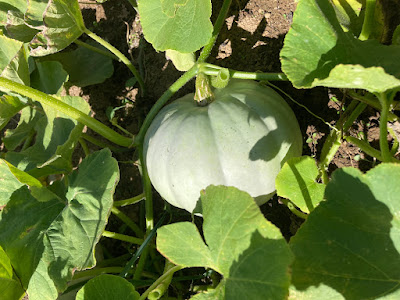
The summer months of January and February were hot and dry, and it wasn't long before the pumpkins began changing colour. I was watering the plants as often I could, but by this time our neighbourhood was under strict water restrictions.
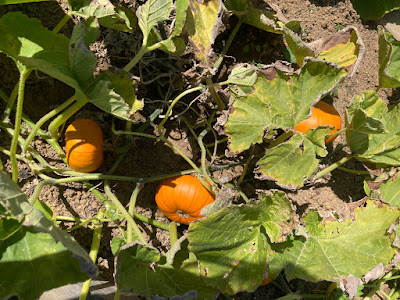
In early March the pumpkin plants started dying back, and finally we had some decent rain again. It was now time for the pumpkin harvest. It was our biggest pumpkin harvest ever. Our 6 grey crown pumpkins weighed a combined total of 18 kg, and our 11 Baby Bear pumpkins came in at a combined total of 7 kg.
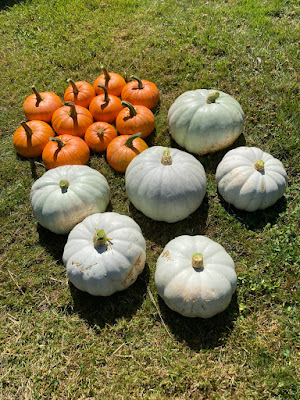
After setting aside pumpkins for our own use, and also for family and friends, we had 6 pumpkins left over. Luckily our neighbourhood has a very active fruit and vege produce swap group. I posted my pumpkins up on their Facebook page, and within minutes all my spare pumpkins were taken by people wanting to swap produce.
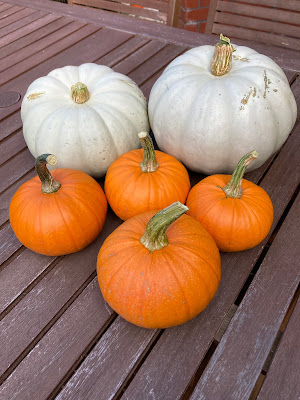
I was very soon inundated with lots of wonderful fruit we don't grow in our own fruit and vegetable garden, and in return I made new friends who left quite happily with a pumpkin or two.
One of our big gray pumpkins got given to an online friend in return for a box of quinces, and you can find the story in one of my previous blog posts, here.
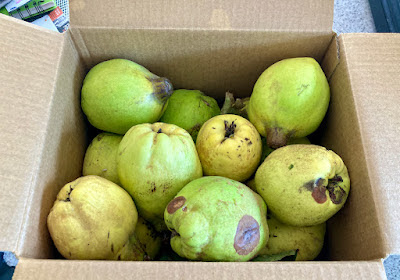
I hope to share with you soon, my other adventures in processing and eating my autumnal fruit bounty.
Have a wonderful day
Julie-Ann
Want to discuss my post? Feel free to chat with me on Instagram or Mastodon.
Our Poached Quince Recipe
Hello friends,
Today I thought I'd share our poached quince recipe with you.
It's the perfect autumnal dessert to eat with vanilla ice cream on a
cool night. And if you have any poached quince left over, just freeze it
away to eat at a later date. Quinces are an acquired taste, just like
feijoas, but once you've tried them, their wonderful aromatic taste will
stay with you all year, as you impatiently wait for their autumn
harvest once again.
The
hardest part of the recipe, is probably finding quinces. When we lived
in Wellington our local New World stocked them for a few weeks each
autumn, so we bought them when we could, and made up a big batch to last
us over the year. Now we live back home in Dunedin, it's a bit harder
to find quinces, as local shops don't stock them. Luckily this year,
I had an excess of pumpkins, and I swapped a big crown gray pumpkin for
a box of quinces with an online friend, but this excess pumpkin harvest
swapping adventure is a whole other story.
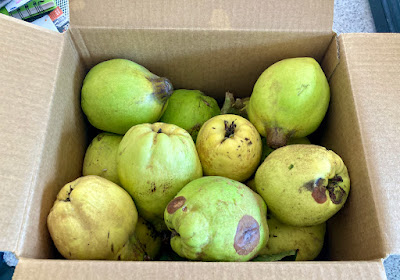
For this recipe you'll need:
3 - 4 ripe quinces
750 mL of water
1.5 cups of sugar
1 cinnamon stick
1 vanilla pod (or 1 - 2 star anise if you can't get a vanilla pod)
The recipe:
1. Peel and core the quinces, chopping off any damaged sections. The fruit are quite brittle and hard, so it's a bit of a job to do. The fruit are unpleasant to eat raw, so I wouldn't advise trying it.
2. Chop the quinces into slices or cubes depending on how you'll want to eat them. The fruit will start to oxidise quickly (turn brownish), but don't worry about that, it'll all turn out okay in the end.
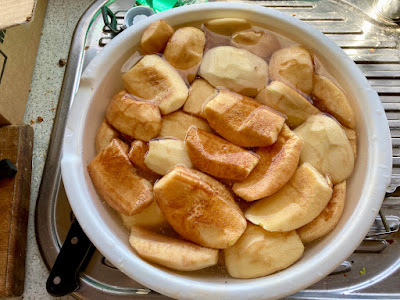
3. To a pot add the water and sugar, mix, and begin to heat to a simmer.
4. Add
the quinces to the pot, and add the cinnamon stick and vanilla pod. You
can swap out the vanilla pod for star anise if you want, but personally
I prefer the vanilla pod.
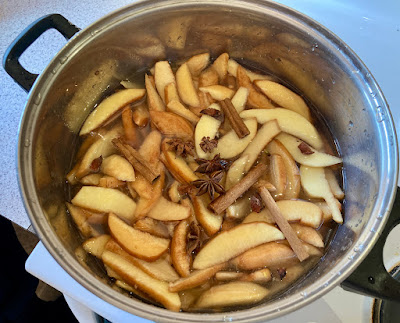
5. The next thing to do is to make a paper cartouche for the quince mixture. A cartouche is a parchment paper lid, and it covers the surface of the poaching mixture. It traps the steam, and keeps the components submerged in liquid. We just cut off a section of grease proof paper, and folded it so it fitted on top of the quince mixture. It is important to mold it to the mixture so it keeps everything wet.
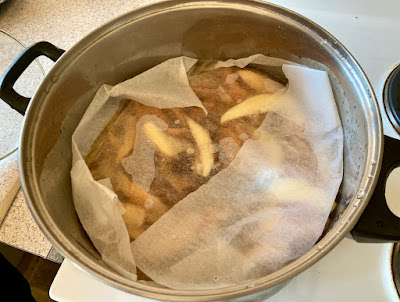
6. With the lid of the pot off, heat the mixture up, and then let it simmer for an hour. Over time the quinces will slowly change colour, changing from a creamy yellow, to a dark rose pink. This is the colour at the 30 minute mark, it hasn't changed to a pink shade yet.

7. This is the colour at the 60 minute mark. The quinces now are a rose pink, but not quite dark enough. If you do a taste test you'll find them still slightly bitter, but the quinces will be soft like cooked apples.
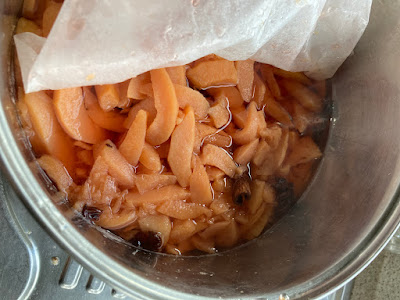
8. What you are looking for is a slightly darker shade of rose pink, and the quinces will taste highly aromatic. When you're happy with the flavor and taste, remove the cinnamon stick and vanilla pod (or star anise) from the mixture. Remove the pot from the heat.
9. The
only thing left to do is eat it, storing any left overs in the fridge
or freezer. I recommend having it while still warm (or re-heating in the
microwave), with some good quality vanilla ice cream. The vanilla ice
cream really brings out the aromatic quince flavor.
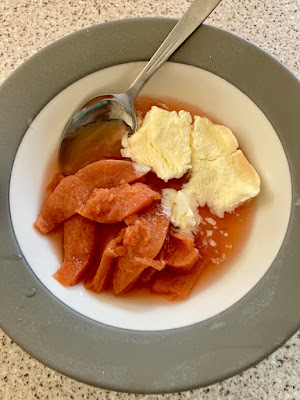
I hope you get a chance making our poached quince recipe yourself over the autumn season, they really are a wonderful fruit. We currently have a fresh batch stored in the fridge to eat this week, and also a couple of frozen batches stored away for later on in autumn and winter.
Please let me know if you give this recipe a go, and tell me what you think of it.
Have a wonderful day.
Julie-Ann
Want to discuss my post? Feel free to chat with me on Instagram or Mastodon.




